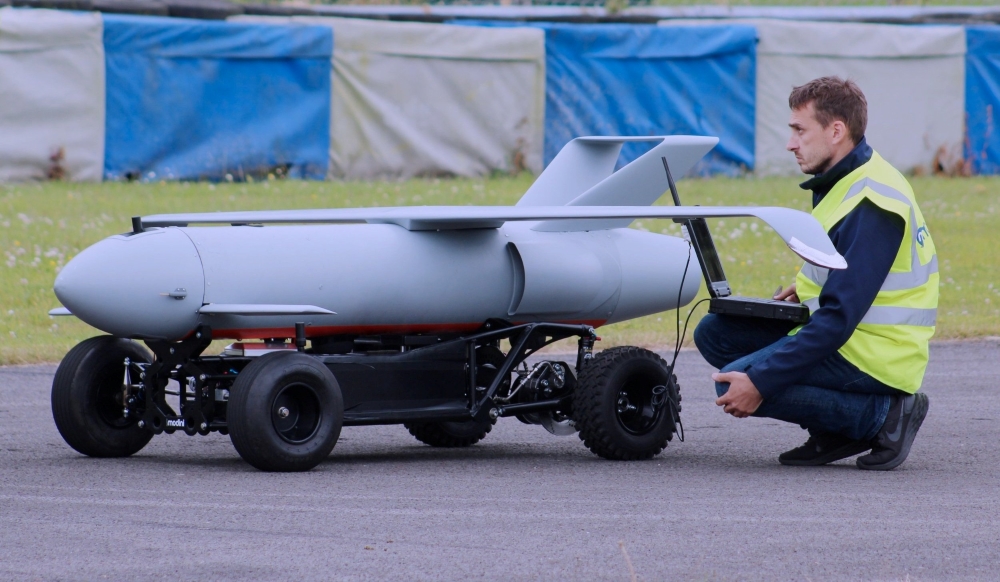
A £7.5 million order has been placed by the Ministry of Defence with British firm Modini Ltd for the supply of an unspecified number of “one way strike” drones.
While the type of drone is not univocally identified in the contract award notice, it is thought the munition involved is the DART 250, which Modini already produces for Ukraine. The contract award specifies that Modini was selected because it could ensure quick production and supply, with the aim of receiving the first few drones early in 2025 ahead of a first operational deployment already in the summer within Operation CABRIT, the British-led battlegroup in Estonia as part of the NATO Forward Land Force.
The DART 250 is a one-way attack drone credited with a range of 250 km and a speed of more than 400 km/h while flying in terrain following mode at 50 to 100 feets above the ground. It can fly accurately even when GPS signals are jammed and denied thanks to its on-board navigation system. The drone takes off from a dolly, with a takeoff run of less than 120 meters, but Modini is also working on catapult launch modes and even, reportedly, on air launch. During 2024 the Company showcased an “EW” derivation of the DART 250, fitted with an RF passive seeker that enables it to home on hamming frequencies to counter enemy electronic warfare.
A variant for reconnaissance and target-finding, integrating AI functions for advanced surveillance, is also in the works while Modini is already thinking of a DART 350 with extended range and greater payload (up to 25 kg). The procurement of Modini’s One Way Strike drone fits within the larger Project ASGARD, which the Army hopes to spirally develop over time beginning in 2025. The aim of ASGARD is to create a “reconnaissance & strike” system of systems able to find targets, disseminate information and prosecute the targets in deep with a faster operational tempo. ASGARD is thus looking at “effectors”, such as this one way strike drone; and enhanced digital C4I and network solutions.
In recent months the Army has accelerated its programs for strike drones beyond this first contract: the Army has been in talks over November and December with industry over its requirement for a “Medium Range Precision Strike” user-portable loitering munition for which it wants a minimum range of 60 km and a loiter time of 40 minutes with a minimum speed of 100 km/h. The munition must be able to destroy enemy armour and be able to be controlled by the operator to enable attack interruption and re-attack if needed. For safe storage, the battery and/or warhead must be amovable. MRPS is aiming for a minimum initial quantity of some 200 munitions for delivery from 2027.
Another project, BRAKESTOP, intends to get to live testing stage early in 2025, with the intent of then producing it at a rhythm of “at least” 20 per month beginning in Q3 2025. BRAKESTOP is to be a long range (600 km) “one way effector” with a lethal payload comparable to a 500 lbs MK82-type bomb. Via the Defence and Security Accelerator (DASA) agency, the Army is also trying to accelerate its work on Air Launched Effects, engaging industry for proposals for air launched drones at Technology Readiness Level 4 or higher.
The aim is to develop an “uncrewed Deep Recce Strike platform capable of operating at ranges greater than 80km” in which one “main” drone will deliver Intelligence, Surveillance, Target Acquisition and Reconnaissance (ISTAR) capability for identifying dynamic targets and direct other one-way strike effectors onto them while loitering to conduct initial Battlefield Damage Assessment (BDA) after the attack.
The Army Air Corps has been carrying out some experimentation with air launched effects for several years now, in particular working with the Anduril ALTIUS 600 in cooperation with the AW159 WILDCAT scout helicopter.
Adopting the same payload-carrying “wings” already used on the Royal Navy’s own WILDCAT HMA2 variant, the Army could carry up to 20 ALE effectors, completely revolutionizing the helicopter’s battlefield role and lethality.








.png)
